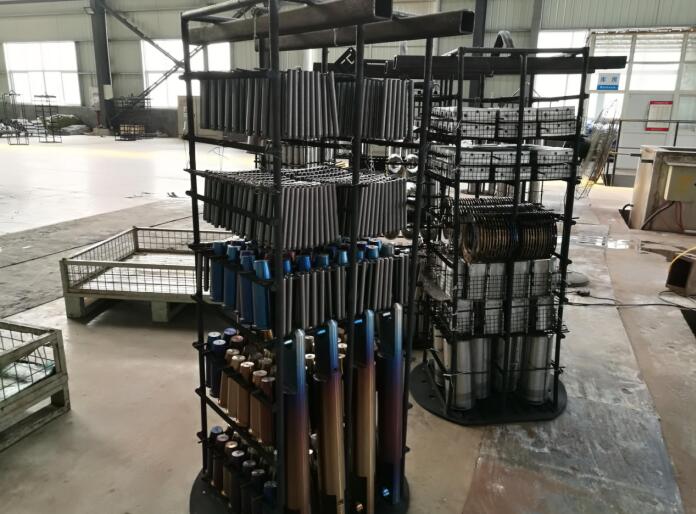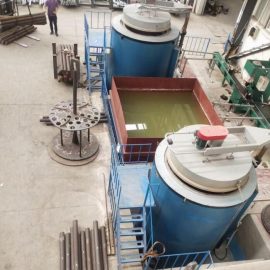QPQ Salt Bath Liquid Nitriding Process Specification
1. Process
Loadingbasket→degreasing cleaning→rinsing→preheating→nitriding→air cooling→oxidation→hot water cleaning→clean water rinsing→dehydration and drying→rough polishing→fine polishing→loading basket→preheating→oxidation→hot water cleaning→ Rinse with clean wate→dehydration and drying→fine polishing→soaking in anti→rust oil or emulsified anti rust oil→wipe off the oil
2. Operating procedures and matters needing attention
A. Process and parameter requirements
1. The material basket should be a special material basket, and the furnace load should be controlled within 35% of the salt weight in the crucible, otherwise it will affect the thickness of the infiltration layer.
2. After cleaning the oil, the residual liquid of the cleaning agent must be rinsed, otherwise the preheating will cause corrosion spots.
3. Preheating: The preheating temperature is 320~350℃, and the heat preservation is 0.30~1.0h. Note that the color is blue and yellow, and the color of the whole basket is the same.
4. Nitriding: 575°C (560-580°C), keep for 2.0 hours, and start counting the holding time when the temperature is raised to 565°C. Note that after the workpiece enters the furnace, the furnace temperature cannot be lower than 530°C, otherwise corrosion marks will occur.
5. Pre-cooling: After being exuded from the furnace, pre-cooling to about 480°C (be careful not to let the salt solidify) before entering the oxidation furnace for oxidation.
6. Oxidation: ****** times (after nitriding) oxidize at 380~420℃, keep 15-30 minutes; ****** times (after polishing) oxidize 410~430℃, keep 45~90 minutes .
B. Salt bath maintenance
After opening the furnace to build the bath and normal use:
1. Nitriding furnace (NJ 200 kg in the pot)
⑴. Add the base salt NJ-1 once a day (24 hours), and the amount added is subject to the height of the original liquid level when the salt is added.
Note: Do not add salt if there is a workpiece in the pot!
⑵. Half a day (approximately 12 hours apart, refers to the operating time of the salt bath, not the time to process the parts) plus 1 time of regeneration salt ZS-1, the amount of addition is about 1.7 kg, note: a small amount of addition in batches; no treatment Parts should also be added. As long as the salt bath is running, the activity of the salt will always decrease, and regeneration salt must be added to regenerate and recover.
Note: a. Remember to add 0.5 kg of regeneration salt every time the salt is melted in the cold furnace! b. There is a workpiece in the pot, do not add salt!
⑶. Slag removal once a day (24 hours), it takes about 30 to 45 minutes to remove sediment and scum. Hanging basket for dredging scum; fishing net for dredging scum.
2. Oxidation blackening furnace (YH 210 kg in the pot)
Remove the slag, add new black salt YH-1 when the liquid level drops, and add the amount: make up to the sufficient liquid level. Note: When the added amount exceeds 10% of the weight of the salt in the pot, it must be heated to 450°C and then lowered to the processing temperature before the workpiece can be processed.
Note: Do not add salt if there is a workpiece in the furnace!

3. Slag removal
1. Scraping scum: That is salvaging floating objects floating on the surface of the salt solution.
⑴. Tools: self-made slag fishing net,
ø 250~300, make a tennis racket; 60~100 mesh stainless steel net
⑵. Slag removal time:
a. Each time the salt is added (nitriding furnace: base salt or regeneration salt; oxidation furnace: oxidizing salt), fish once after melting or reaction.
b. Use a small slag removal tool to remove the suspended matter brought into the furnace by the workpiece.
2. Removal of sediment: that is, remove the fine particles in the salt solution.
⑴. Tools: Self-made slag removal tools, two kinds are required: 1. Long small rake; 2. Hanging basket.
⑵. Time: Nitriding furnace: fishing once every 24 hours; Oxidizing furnace: fishing once every 48 hours.
⑶. Method:
After the workpiece is released, prepare for slag removal: first add about 0.20kg of base salt regulator NT-1, and after the foam has subsided, clean the solidified salt around the pot mouth. Note: Wear gloves and use a long spoon to scoop salt, and seal the leftover salt pocket in time.
First, use a long small rake to rake the slag at the bottom of the pot, cover the furnace cover to keep it warm, increase the ventilation rate, and increase the temperature setting to 600°C. After the temperature rises to 600°C, set the temperature again after 1 hour. Set it up to the processing temperature, such as 575°C. After taking out the vent pipe and thermocouple from the crucible, put it in the slag hanging basket, and when the hanging basket falls to the bottom, lift it up a short distance and press it down, so that the bottom slag can be flushed up, remember to turn the thermoelectric Even put it back in the pot! Cover the furnace cover and let the salt bath stand still for more than 30 minutes. (Of course, the longer the standstill time is, the better). The liquid surface does not solidify (575℃). Hanging basket! Produce or pour the silt-like residue in the basket. If the slag has not been collected, it must be fished again according to the above method.
Note: Even if there is no processing quality problem, you must perform the normal slag removal work, don’t be careless!
Slag removal time (the slag removal cycle is one furnace after drying 24 or 48 hours a day).
a. Nitriding furnace: about once every 24 hours;
b. Oxidation furnace: about once every 48 hours.
4. Matters needing attention
1. After the workpiece is put into the furnace, the furnace temperature should not drop to 530°C, otherwise the processing quality will be affected; the furnace load should be reduced.
2. All materials that enter the crucible should be preheated to avoid splashing; the tools should be made of solid rods; the dryness of the ventilation system should be checked every day, and the air should be ****** dry.
3. It is not allowed to adjust the salt bath during the processing, that is, it is not allowed to add base salt or regeneration salt to ensure the quality and safety of the workpiece.
4. The salt bath must be kept clean, the slag will affect the depth and hardness of the infiltration layer, and accelerate the decomposition of CNO-; remove the slag regularly.
5. Wear overalls and gloves at work; be sure to wear a face mask when entering the furnace or adding salt to ensure safety.
6. Each time the cold furnace is turned on to regenerate salt, the furnace temperature (the temperature outside the crucible) should be controlled not to exceed 690℃, otherwise it will burn the base salt and accelerate the aging of the salt bath. As long as the control and maintenance are good, the salt bath can be long-term No aging, no trouble of waste salt treatment.
7. Take out the scum, slowly go down with the fishing tackle on its side and slowly move upwards. After the fishing tackle comes out of the salt surface, you should tap the scum bucket lightly, taking care not to break the net. Just fish two to three times.
8. After the oxidizing salt bath is used for a long time, due to the nitriding salt that is brought in continuously, a large amount of carbonate is accumulated in the oxidizing salt (the melting point of carbonate is greater than 700 ℃), which increases the melting point of the oxidizing salt (oxidizing salt). The bath is like tofu residue), that is, there are many residues. ****** Remove the slag before turning off the power and stop the furnace, so that the salt (carbonate) at the bottom of the oxidation salt bath will not melt when the furnace is turned on next time.
9. When adding oxidized black salt, if foam is found, it means that the salt has regained moisture. It should be added in small amounts in batches. Regaining moisture (but not turning into liquid) will not affect the quality. Pay attention that after adding the salt, you should wait. After the salt bath temperature rises to 430°C, it is lowered to the treatment temperature and held for 30 minutes before entering the furnace to oxidize the parts.
10. When the one-time supplement of oxidizing blackening salt exceeds 10% of the weight of the salt in the pot, the temperature of the salt bath should be raised to 450°C and then cooled to 400-430°C for use; avoid oxidation redness.
11. When the parts are not processed by the nitriding salt bath, air must be ventilated, and the air must be ventilated when processing the parts. The air volume should not be too large; when the parts are processed by the oxidizing salt bath, increase the air volume as much as possible! It is subject to the salt solution not turning out of the pot.
12. The temperature control instrument setting of nitriding furnace and oxidizing blackening furnace: the temperature control of the furnace (outside the pot) is 30~80℃ higher than that of the brine (inside the pot).
13. The control range of the main components of the nitride salt bath: CNO-32±2%.
Learn More :
Advantages of Strong Convection Full Hydrogen Bright Bell Annealing Furnace Pit Type Gas Nitriding Furnace Process Operation Specification Heat-Treated Refractory Fibers Characteristics And Classification


Contact us
Your email address will not be published. Required fields are marked *